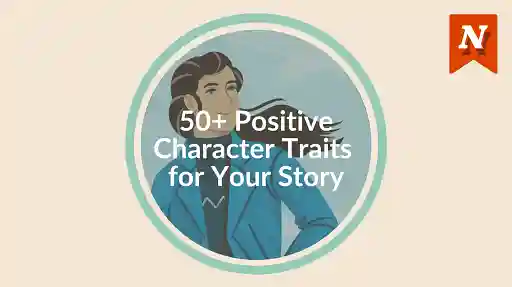Whether you're an aspiring writer or have a few novels under your belt already, integrating backstory into your narrative takes practice. In this article, we’ll pin down exactly what character backstory is and provide you with all the tips and tricks you’ll need to achieve a well-balanced backstory.
What is character backstory?
Put simply, character backstory refers to everything that has happened to a character before we meet them at the beginning of a novel. This includes anything from where your character grew up to any major life events or particularly painful memories that have stayed with them for life.
Building a believable backstory is a crucial part of creating well-rounded characters that resemble real people. If we look at writing as painting a portrait of your character, a solid backstory is what’s going to transform them from a simple pencil sketch to a fully-fledged oil painting.
How to uncover backstory
Pulling an entire character backstory out of thin air might sound like an impossible task. Luckily, there are a few trusted tools that are guaranteed to help elevate your characters, which we’ll cover below.
👤 Use character profiles
A surefire way of uncovering your character's backstory is to create a character profile. Imagine you’re having a coffee with your character – what questions would you ask to better understand their personality? These could range from surface-level questions like “What is your favorite outfit to wear?” to deeper questions, such as “What is your most cherished childhood memory?”
In his memoir On Writing, Stephen King writes of his characters: “My job isn’t to help them work their way free, or manipulate them to safety — those are jobs which require the noisy jackhammer of plot — but to watch what happens and then write it down.”
The goal of the backstory development process isn't necessarily to produce content to be included in your story, but rather to understand how your protagonist would react at any given turn of the plot. Starting with smaller personality traits and habits is a fantastic way to get to know your character on a personal level and better visualize their unique look and quirks.
Free Character Profile Template
A story is only as strong as its characters. Fill this out to develop yours.
⌛ Create life timelines
Once your character profile is completed, the next step is to create a timeline of what has happened to your character before we meet them in the opening pages. Think carefully about the formative events that might have shaped your character:
- Were they the oldest child or the youngest child?
- What were they like at school?
- What was their first job?
Once you have a few ideas, one idea is to keep a separate document where you can work on bringing these events and memories to life — almost like a diary for your character.
Again, this material probably won’t end up in your story; however, the better you can understand the life your character has lived, the better you will be able to predict their reactions to the dramatic plot twists you might be planning to throw at them.
🤔 Draw from real-life experiences
It is certainly true that the most well-rounded characters are the ones that feel human. If writing your backstory is proving difficult, it may be helpful to look at the people around you for inspiration — perhaps your friends, family, or even celebrities!
You might even find that one of your own memories aligns perfectly with something from your character’s life or personality. Either way, giving your characters this kind of authentic dimensionality is guaranteed to engage readers with your story: people like to see their own lives and struggles portrayed in fiction.
A famous example of using real-life experiences in fiction comes from Margaret Atwood’s The Handmaid’s Tale, about which she wrote: “I made a rule for myself [that] I would not include anything that human beings had not already done in some other place or time, or for which the technology did not already exist.”
Through this added realism, Atwood’s novel has since become a modern classic, acclaimed by readers for its prophetic nature.
Incorporating backstory into your plot
Now that your character’s portrait has a bit of shading and better-defined features, it’s time to bring them to life by incorporating their backstory into your plot.
🏃 Identify what drives your character
After curating a character profile and plotting out a timeline, you should be able to pick out some key moments from your character's past that are strong enough to serve as their motivation or other explanation for their behavior. Perhaps they were badly bullied at school and, as a result, became motivated to seek revenge on their bullies by tracking them all down later on in life.
The BBC dramatic comedy Fleabag does an excellent job of showing how the protagonist’s past impacts her present. As she takes us on her often self-destructive romantic escapades, we are faced with flashbacks about the life — and death — of her best friend Boo.
These flashbacks are a visual representation of how Fleabag’s grief can be triggered at any moment, and add a degree of psychological realism to the story. Incorporating an emotional or psychological drive adds great depth to your character and is vital in making your story emotionally engaging!
👀 Know when to reveal backstory
Every piece of backstory should be relevant and serve the plot in some way — if your character was bitten by a dog as a child, they wouldn’t bring this up unprovoked in a casual conversation.
In real life, we don’t constantly focus on the past; instead, memories are triggered by conversations, sensory cues, or geographical places. Specific memories in a story should be introduced as a direct response to plot points — perhaps your protagonist’s love interest has a dog, and your protagonist's fear of dogs is driving them apart. This fear might only come up when the dog gets a bit too close for comfort and your protagonist can’t contain their panic.
If we look back at Fleabag, whilst we are shown the flashbacks to Boo’s death pretty early on, the reason behind her death is not given until the last episode of season one. This completely changes our perception of Fleabag from someone who is mysteriously down on her luck, to someone who is suddenly a morally grey character. Delaying the reveal of certain elements of backstory is a powerful way to build tension or create dramatic plot twists.
🤲 Remember: show, don’t tell
This classic piece of writing advice is as true as ever when it comes to writing character backstory. Including too much “told” backstory can make your narrative long-winded and boring — but thankfully there are a few ways to incorporate backstory naturally!
Try using one of the following:
- Dialogue — Characters often reveal intimate details of their pasts when talking to familiar characters, or as it becomes relevant to their unfolding experiences; this is a great example of indirect characterization. We might see a more vulnerable side to a character when they are speaking to their mother, for example, as opposed to a stranger.
- Flashbacks — Specific encounters can trigger memories or explosive responses. And of course, flashbacks are only “visible” to the character who’s having them, providing another way to create tension and foster secrets between character.
- Parallel timeframes — This occurs when a character’s story unfolds alongside an earlier timeline setting that shows their past unfolding. A dynamic example of this can be seen in Stephen King’s novel, IT, where the narrative switches between the childhood and adulthood of the kids affected by Pennywise. Many of the characters' childhood traits then worm their way into adulthood, and become more pronounced in time of stress. For example, Bill's youthful stutter reappears when he learns that Pennywise has risen again, deftly representing the trauma of his past.
These tools will help to provide important insight into your character's life and personality without info-dumping. Your reader wants to get to know your character as they might a new friend — following these tips will make that a lot easier.
Just remember, a story is only ever as good as its characters — so don’t be afraid to spend time plotting out as many of their thoughts and feelings as you can think of. Next time you find yourself lost in the void of character creation, remember these tips to guarantee that your backstory will take your character to the next level!











Number five for the win. Less truly is more.
Elias Mc Clellan - Over 6 years ago
Agreed, Elias! Thank you for sharing your thoughts.
Jordan At Now Novel - Over 6 years ago
Tips for writing better articles. 1. Hire writers that have a basic command of the English language.
Hilstad - About 6 years ago
Hi Hilstad, you can send your CV and writing samples to help@nownovel.com. Have a great week :)
Jordan At Now Novel - About 6 years ago
Great article! I especially liked the info-graphic. Also, isn't it funny how most advice with writing can be summed up with "show, don't tell"? I just published an article about writing compelling villains that linked back to this one. If anyone is interested, hope it helps out on your character designing journey. You guys at Now Novel might also appreciate it. https://thewrittenwerd.com/believable-villains/
Anthony Stinson - Over 5 years ago
Thanks, Anthony! It's true, that's a common piece of advice (although Ursula Le Guin has written a great defence of telling here: http://ursulakleguinarchive.com/AboutWriting13-OnRulesofWriting.html Thank you for the mention, and for sharing our blog!
Jordan At Now Novel - Over 5 years ago
I really don't fine this helpful
Me - About 5 years ago
I'm sorry to hear that! What specific character issue are you working on, or rather what were you looking for? Thank you for reading our blog.
Jordan - About 5 years ago
Jordan, great article. I’ve completed an action thriller and my editor says my backstories interrupt the flow of the narrative. She agrees they are necessary but how should I smooth them out? This is the beginning of a series so there is a lot of pertinent info. Any ideas particularly with my editor’s concern for flow? Thanks. Eric
Eric Barr - About 5 years ago
Hi Eric, thank you for the kind feedback and for reading our blog. Congratulations on finishing and being at this stage in development. It's difficult to advise in the abstract without reading the work and pinpointing where the balance may begin veering off. I would suggest asking your editor for notes on where the backstory begins to overwhelm the present-time narration and distract/detract from it. Sometimes it's difficult to see these subtleties oneself, being so enmeshed in the process and story itself. Generally, it's ideal if backstory can be brought in in such a way that it is unobtrusive and connects or relates to the presently unfolding scene. For example, if a military vet were triggered by a backfiring motorbike because it sounds like gunfire, and this brought in a brief recollection of a memory from the front, it would perhaps keep the balance of focus on the unfolding scene and present time. It would give a sharp sense of the consequences of the past on the present, like a pinprick, rather than a meandering wander deeper into events that have at this point in narrative time passed, and may not be required in exhaustive detail by the present action. I hope this helps? Please feel free to mail any further questions to help@nownovel.com. Thanks again for the great question.
Jordan - About 5 years ago
Thank you Jordan, I find this a great article. What happened in my life in 1969 at age 14 has led to the best 9 years of my life that only started in 2011 and my fairy tale ended in August 2020, when my sole mate passed away. I always said that I was going to write a book. Your article has inspired me.
Sarie - Over 4 years ago
Thank you for sharing that, Sarie. I'm sorry to hear of your loss, but glad that those 9 years were like a fairy tale. Do it, I'm sure you have a moving story to tell. Happy writing ?
Jordan - Over 4 years ago
how do i make a good backstory for a cute things
Pirate Lord5 - Over 4 years ago
Hi there, could you maybe provide a little more context? What sort of cute things do you want to create backstory for?
Jordan - Over 4 years ago
Thank you, Jordan. The article is a gem and so are your replies. They really warm my heart for some reason
Ti - Over 4 years ago
Thank you for the kind feedback, Ti. I'm glad you're enjoying the blog. Happy writing.
Jordan - Over 4 years ago
This was so incredibly helpful. Thank you, Jordan.
Josephine - Almost 4 years ago
Hi Josephine, thank you for your kind feedback, I'm glad to hear that. It's a pleasure, thank you for reading our blog.
Jordan - Almost 4 years ago
This is so very helpful. It really gets to the heart of backstory and character development. I’m a complete novice and am inspired by your kindness in the comments.
Grammye - Over 1 year ago
Thanks so much for reading the blog and your kind words! I'm very pleased you found it useful. The post gives some really useful tips for creating a backstory for characters. These include brainstorming formative events that shape your characters, as one idea. Balancing telling backstory with showing, by keep some information back to reveal gradually. And you can also draw on people you know to create backstories.
Arja Salafranca - Over 1 year ago